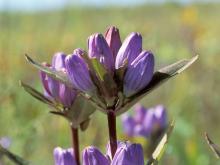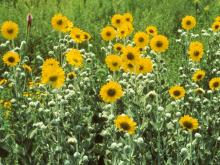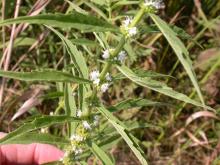Wildflowers, Grasses and Other Nonwoody Plants
Media

Species Types
Scientific Name
Eupatorium perfoliatum
Description
American, or common boneset has small, white flowerheads in flat-topped clusters at the top of the plant. The leaves are hairy, narrowly triangular, and in opposite pairs fused around the stem.
Media

Species Types
Scientific Name
Eupatorium altissimum
Description
A stout perennial that can grow to 6 feet tall, tall thoroughwort is a member of the sunflower family that has dull white flowers and distinctive leaves that are opposite, slender, very short-stalked, and with three quite noticeable veins.
Media

Species Types
Scientific Name
Gentiana andrewsii
Description
Closed gentian, or bottle gentian, never opens — it stays closed and budlike throughout the pollination process. How is it pollinated? Bumblebees push their way into the flowers!
Media

Species Types
Scientific Name
Helianthus spp.
Description
Most people recognize sunflowers when they see them, with their bright yellow ray flowers and rather flattened center of dark disk flowers. There are 16 species of Helianthus in Missouri.
Media

Species Types
Scientific Name
Eupatorium serotinum
Description
Late boneset, or late-flowering thoroughwort, is a native perennial wildflower with clusters of white, fuzzy-looking flowers. It’s one of nine similar-looking species of thoroughworts in Missouri.
Media

Species Types
Scientific Name
Eupatorium spp.
Description
Nine white-flowering species of thoroughworts, or bonesets, have been recorded for Missouri. They have rounded flower clusters that look rather fuzzy, because each little composite flowerhead lacks petal-like ray florets.
Media
Species Types
Scientific Name
Salvia azurea
Description
Blue sage is easily identified by its wandlike clusters of sky-blue, two-lipped wildflowers. It blooms July–September in prairies, roadsides, and other open habitats.
Media

Species Types
Scientific Name
Lycopus americanus
Description
Not the showiest of wildflowers, American bugleweed will catch your eye with its interesting geometry. The narrow, toothed leaves are opposite on the stalks and occur at right angles to the pair below.
Media

Species Types
Scientific Name
Scrophularia marilandica
Description
Eastern figwort occurs statewide in rich woods, woodland borders, and bottomlands. It’s usually 2-5 feet high, has square stems and lance-shaped, toothed leaves, and bears spreading clusters of small, green scoop-shaped flowers with brown petal lobes.
Media

Species Types
Scientific Name
Buchnera americana
Description
American bluehearts is a single or few-stalked wildflower of prairies and glades. It has distinctive, showy purple flowers that turn black as they age.
See Also
About Wildflowers, Grasses and Other Nonwoody Plants in Missouri
A very simple way of thinking about the green world is to divide the vascular plants into two groups: woody and nonwoody (or herbaceous). But this is an artificial division; many plant families include some species that are woody and some that are not. The diversity of nonwoody vascular plants is staggering! Think of all the ferns, grasses, sedges, lilies, peas, sunflowers, nightshades, milkweeds, mustards, mints, and mallows — weeds and wildflowers — and many more!





















